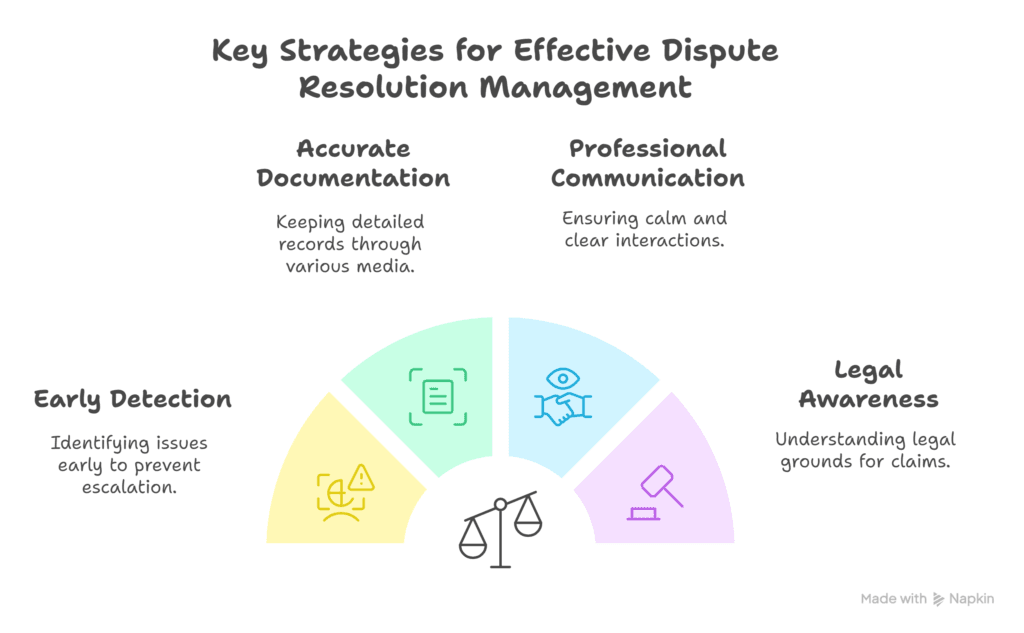
The Ultimate Guide to Construction Dispute Resolution
Construction dispute resolution can be stressful and disruptive. Whether you’re a homeowner facing unexpected defects or a builder navigating complex warranty claims, having a clear strategy is essential. In this guide, we break down every step—from initial documentation to legal resolution—to help you resolve construction issues swiftly and effectively.
Understanding Construction Dispute Resolution
Before diving into dispute resolution, it’s crucial to understand the landscape. Construction disputes may arise from minor defects or major structural problems. Effective resolution depends on clear documentation, timely communication, and a thorough understanding of your rights under industry regulations and contractual obligations.
Key Elements of Successful Dispute Resolution:
Early Detection: Identify issues before they escalate.
Accurate Documentation: Use photos, videos, and detailed written records.
Professional Communication: Maintain calm and clear dialogue with contractors and insurers.
Legal Awareness: Know the legal grounds supporting your claim, such as breach of contract or negligence.
Home Dispute Resolution: Taking the First Steps
For homeowners, the initial phase of dispute resolution is critical. From minor defects to major issues, the first step is always to document the problem meticulously. Here’s how:
Capture Evidence: Photograph and video the defect with clear descriptions.
Direct Contact: Speak with your builder or contractor immediately. A calm conversation often leads to swift resolution.
Detailed Record-Keeping: Note every communication and any agreed-upon timelines for fixes.
This proactive approach not only helps resolve issues faster but also builds a strong case if the dispute escalates.
Managing Warranty and NHBC Claims
The National House Building Council (NHBC) plays a key role in managing construction defects for new homes. If your property is covered under NHBC, you have access to warranty support that can cover various defects.
Steps for NHBC Dispute Management:
Familiarize Yourself with Coverage: Understand what defects are covered and the time limits (typically 2 years for minor issues and 10 years for structural concerns).
File a Claim Promptly: Once defects are identified, report them to NHBC before the warranty period expires.
Independent Inspections: Consider hiring a third-party inspector to support your claim if you suspect NHBC’s initial review has overlooked an issue.
Using these strategies can streamline the process and increase the likelihood of a favorable resolution.
How to Complain Effectively: Best Practices for Construction Disputes
When you’ve documented your issues, the next step is to communicate your complaint effectively. Follow these best practices to ensure your concerns are heard:
Document Every Defect: Keep a detailed log with photos, videos, and written descriptions.
Reference Contract Details: Cite specific contractual obligations and building codes that haven’t been met.
Specify Your Desired Resolution: Clearly articulate what actions you expect to be taken.
Maintain Professionalism: Use respectful, clear language in all communications.
Consistent Follow-up: Set and adhere to a follow-up schedule to track progress.

For a hassle-free process, use a template letter to ensure you cover all the necessary points when submitting your complaint.
When to Escalate Your Complaint
Timing is everything in dispute resolution. Knowing when to escalate can make all the difference in achieving a satisfactory outcome:
Safety Issues: Immediately report any defect that poses a risk to health or safety.
Visible Defects: Raise concerns within two weeks of noticing any visible problems.
Repeated Failures: If initial repair attempts have failed, escalate your complaint.
Approaching Warranty Expiry: Act before the warranty period ends to secure your rights.
Sufficient Evidence: Only escalate once you have comprehensive documentation to support your claim.
By following these guidelines, you can ensure that your dispute receives the attention it requires before issues become more complex.
Legal Duties and Grounds for Construction Disputes
Builders are legally obligated to meet specific standards and contractual specifications. Understanding these legal grounds not only empowers you but also strengthens your claim. Common legal bases include:
Breach of Contract: When builders fail to deliver work as specified.
Negligence: Poor workmanship that results in damage.
Violation of Building Codes: Non-compliance with industry standards.
Breach of Warranty: Failure to honor warranty commitments.
Misrepresentation or Fraud: Inaccurate information regarding construction quality.
Armed with this knowledge, you can better negotiate or take legal action if necessary.
Timeline for Resolution: What to Expect
The time it takes to resolve construction disputes can vary widely:
Standard Defects: Expect a response within 2-4 weeks and resolution within 1-3 months.
Major Structural Issues: These may require 3-6 months for complete remediation.
Legal Proceedings: If the dispute goes to court, resolution can take 1-2 years or longer.
By understanding these timelines, you can manage your expectations and plan your next steps accordingly.
Warranty Providers: Options and Considerations
Different warranty providers offer various levels of coverage. Here’s a quick overview:
NHBC: Offers a 10-year warranty (minor issues covered for 2 years, structural for 10 years).
Premier Guarantee: Provides similar coverage to NHBC with additional customer support.
LABC Warranty: Works closely with local building authorities for compliance.
Self-Build Warranties: Tailored coverage for those who build their own homes.
Always review your warranty terms carefully to know your rights and the process for filing a claim.
Conclusion: Your Path to a Successful Resolution
Resolving construction disputes may seem daunting, but by taking a systematic approach—documenting issues, communicating clearly, and understanding your legal rights—you can effectively manage and resolve even the most challenging disputes. Remember, early action and thorough documentation are your best allies in this process.
For further insights and practical resources, explore the following links:
By following these expert strategies, you can secure a smoother, faster resolution to any construction dispute.
This comprehensive guide is tailored to provide actionable advice and improve your dispute resolution outcomes—ensuring you stay informed and prepared every step of the way please see a free downloadable Construction Complaint Template Letter
#ConstructionDisputeResolution
#ConstructionLaw
#ConstructionClaims
#DisputeResolution
#KnowYourRights
#ConsumerProtection
#PropertyDisputes
#LegalForHomeowners
#BuildingRegulations

